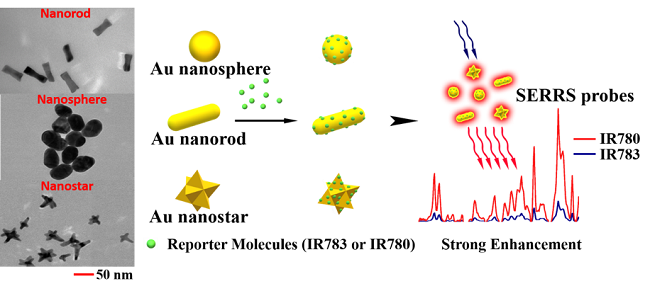表面增强共振拉曼光谱 (SERRS) 由于具备高灵敏度,高信号稳定性,特征指纹峰明显等优势,在肿瘤早期诊断及引导手术切除等方面展现巨大潜力。复旦大学药学院李聪课题组张云飞同学经研究发现当使用七甲川花箐衍生物(IR780和IR783)作为SERRS报告分子时,报告分子化学结构的微小改变可引起SERRS信号的显著增强(IR780较IR783的增幅可达到14倍)。此项研究证明:优化花箐类衍生物化学结构是提高SERRS纳米金探针灵敏度的有效途径。上述工作已发表在Journal of Innovative Optical Health Sciences杂志上。
文章链接:http://www.worldscientific.com/doi/10.1142/S1793545816420050。

花箐类衍生物化学结构调整能够显著提高纳米金探针SERRS信号
Abstract:Surface enhanced resonance Raman scattering (SERRS) is a physical phenomenon that occurs when the energy of incident light is close to that of electronic excitation of reporter molecules (RM) attached on substrates. SERRS has showed great promise in healthcare applications such as tumor diagnosis, image-guided tumor surgery and real-time evaluation of therapeutic response due to its ultra-sensitivity, manipulating convenience and easy accessibility. As the most widely used organic nearinfrared fluorophore, heptamethine cyanines possess the electronic excitation energy that is close to the plasmon absorption energy of the gold nano-scaffolds, which results in the extraordinary enhancement of the SERRS signal. However, the effect of heptamethine cyanine structure and the gold nanoparticle morphology to the SERRS intensity are barely investigated. This work developed a series of SERRS nanoprobes in which two heptamethine cyanine derivatives (IR783 and IR780) were used as the RM and three gold nanoparticles (nanorod, nanosphere and nanostar) were used as the substrates. Interestingly, even though IR780 and IR783 possess very similar chemical structure, SERRS signal produced by IR780 was determined as 14 times higher than that of IR783 when the RM concentration was 6.5×10-6 M. In contrast, less than 4.0 folds SERRS signal intensity increase was measured by changing the substrate morphologies. Above experimental results indicate that finely tuning the chemical structure of the heptamethine cyanine could be a feasible way to develop robust SERRS probes to visualize tumor or guide tumor resection with high sensitivity and target to background ratio.


